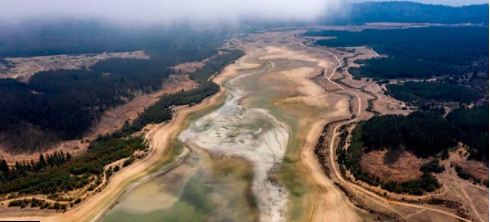The term ‘megadrought’ has started to be used more often in recent years. Continental climates have always suffered from these events but the frequency and severity is increasing. Why? A recent BBC programme, BBC World Service – Discovery, Megadrought in Chile, gave a rather stark warning. An analysis of tree rings going back 1200 years shows that 2/3 rds of the causes of these events are due to natural effects and long term cycles such as La Niňa, but 1/3rd is due to climate change. Chile, western US, Australia and parts of southern Africa and Europe have all experienced lengthy droughts in the last few decades. The situation in California is well documented through wildfires and Australia has experience declining levels of rainfall since the 1970s, which eventually led to the desalination boom in the 2000s. Chile has been in the grip of a megadrought since 2010 and it is now anticipated that it could well last for the rest of the century.
From a water supply perspective, action is clearly needed. In Chile, RO schemes are being implemented using solar energy where possible. An energy cost of 2 kWhr/m3 is claimed for a 50% recovery, which is close to the most efficient systems in use today. However, if desalination were to become standard in all circumstances and regions, we would face an energy crisis.
Closer to home, the experience of ‘megadroughts’ has echoes in many developed economies where summer rainfall has become less reliable. Population densities and water use per capita are so high that even a modest reduction in seasonal rainfall causes havoc with water supply as discussed in previous blogs on 17th May and 16th October.
In the UK, the newly privatized water industry of the 1990s was urged to design treatment and infrastructure for flood and drought events with a frequency of 1 in 100 years. At the time this seemed reasonable. Then in the early years of the 2000s, there were two ‘1 in 100 year’ flood events in the space of 7 years. My local area along the Thames was so famous in the international media that colleagues from California rang me to tell me that I was flooded out! Clearly something is awry with the calculation or something else is happening, that something else being the impact of climate change. The consequence has been to consider the consequences of lower frequency events of 1 in 200 years.
This week I was at a meeting with Ofwat and a UK municipality at which Ofwat asked for data for an even lower event frequency of 1 in 500 years to support projections of water source requirements. Superficially, this seems over the top, but in reality, the impact of climate change means that what happened once in the last 500 years will almost certainly not happen only once in the next 500 years. Unfortunately, this looks like becoming the new normal and our approach to alternative resources will have to respond.
Another issue to come out of the discussion was the public attitude to reuse. The fallback assumption from Ofwat was that the public were not ready for this option yet. In contrast, the municipality found that their customers were more open minded. Which brings us back to RO, whether used for desalination or wastewater reuse. Desalination is more energy intensive and only makes sense as part of a wider solution. Reuse is cheaper and needs to become the standard for anywhere which suffers from irregular rainfall patterns. For a country in the grip of a megadrought, if the RO plant exists, it will be turned on. However, what about locations experiencing stress occasionally and full scale drought only rarely? The challenge for operators using these alternative sources will be ‘How often to run them’? Once built, it will be better to utilize the asset, but what if the running cost is high? Mothballing can be expensive and detrimental for the equipment. Resolving this balancing act will be critical for future water security.

